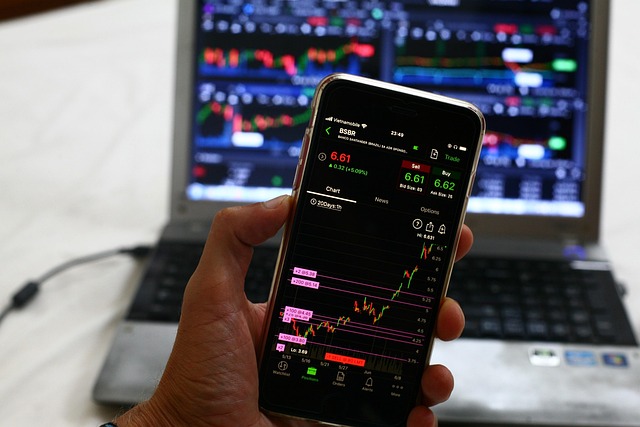ai app for stock market prediction 2025: Practical Guide
Author: Jameson Richman Expert
Published On: 2025-11-02
Prepared by Jameson Richman and our team of experts with over a decade of experience in cryptocurrency and digital asset analysis. Learn more about us.
Summary: This comprehensive guide explains how to build, evaluate, and use an ai app for stock market prediction in 2025. You’ll learn the data sources, machine learning models, engineering best practices, evaluation metrics, deployment options, and real-world considerations including risk management and regulatory constraints. The article includes actionable steps, recommended tools, example architectures, and vetted external resources so you can evaluate or create an AI-powered stock prediction app that is robust, explainable, and production-ready.

Why an ai app for stock market prediction matters in 2025
AI and advanced analytics have matured significantly. Improved natural language models, better time-series architectures (including transformers), broader alternative data, and faster cloud compute make predictive apps more practical than ever. Traders, hedge funds, fintech startups, and retail investors seek AI apps for quantifiable insights — from short-term intraday signals to longer-term trend forecasts. However, realistic expectations, rigorous validation, and careful implementation are essential to avoid overfitting and poor live performance.
Core components of an AI stock prediction app
An effective ai app for stock market prediction has several integrated layers. Below is a high-level architecture with the components you’ll need:
- Data ingestion layer: market data (price, volume), fundamentals (earnings, ratios), news & social sentiment, economic indicators, and alternative data (web traffic, supply-chain signals).
- Data processing & feature engineering: cleaning, normalization, technical indicators (moving averages, RSI, MACD), lag features, event flags, and embeddings for textual sources.
- Modeling layer: time-series models (ARIMA/Prophet), ML (XGBoost, Random Forest), deep learning (LSTM, Transformer-based), and ensemble strategies.
- Backtesting & risk engine: transaction costs, slippage modeling, portfolio constraints, walk-forward validation, and scenario testing.
- Deployment & monitoring: real-time prediction API, dashboards, performance monitoring, drift detection, and alerts.
Recommended tech stack
- Languages: Python (primary), optionally TypeScript/Go for APIs.
- ML frameworks: TensorFlow, PyTorch, scikit-learn, XGBoost, LightGBM.
- Data & compute: Pandas, NumPy, Apache Kafka for streaming, cloud services (AWS/GCP/Azure), or managed ML platforms.
- Visualization & charting: TradingView for live charts (useful with crypto/stock hybrids), Plotly, Grafana.
- Backtesting libraries: Backtrader, Zipline, vectorbt.
Data sources: what to use and where to get it
The quality and diversity of data determine how good an ai app for stock market prediction can become. Combine multiple sources for better signals.
Market & fundamental data
- Exchange data (tick, minute, daily). Public sources: Yahoo Finance, IEX Cloud, Alpha Vantage.
- Official filings and fundamentals: SEC EDGAR (for US equities) and company investor relations pages.
- Licensed data and premium feeds: Bloomberg, Refinitiv, Quandl/Nasdaq Data Link for deeper historical and corporate actions.
News & sentiment
Natural language and sentiment signals can capture market-moving events earlier than price-only models. Use RSS feeds, news APIs (e.g., NewsAPI), and social platforms (Twitter/X, Reddit) with strict preprocessing to avoid noise. Advanced apps use transformer models to get event embeddings.
Alternative data
- Web traffic, app downloads, satellite imagery, credit-card transaction aggregates, and supply-chain data.
- Alternative data requires licensing and careful bias control but can produce alpha if used responsibly.

Model choices: algorithms that work for stock prediction
There is no single “best” model. Choosing models depends on horizon (intraday vs monthly), data frequency, and explainability needs.
Traditional time series and statistical methods
- ARIMA, SARIMA — useful for stationary series and baseline comparisons.
- Prophet — robust for business-cycle and holiday effects; good for interpretability and seasonality.
Machine learning
Tree-based models and ensembles remain strong baselines because they are fast and robust.
- XGBoost / LightGBM: excellent for tabular features and risk factors.
- Random Forest: good for feature importance and simple ensembles.
Deep learning
Deep models can capture non-linear patterns and temporal dependencies, but require more data and careful regularization.
- LSTM/GRU: classic for sequence modeling.
- Transformer/time-series transformers: superior on many sequence tasks thanks to attention; often used in 2024–2025 AI apps.
- CNNs for temporal pattern extraction (1D convs) in high-frequency data.
Reinforcement Learning (RL)
RL aims to optimize sequential decision-making (portfolio allocation, execution). It’s powerful but sensitive to simulation realism — use only after robust environment modeling and rigorous validation.
Feature engineering: what features matter most
High-impact features often combine market structure with alternative signals.
- Technical indicators: moving averages (SMA, EMA), MACD, RSI, Bollinger Bands, ADX.
- Return & volatility features: rolling returns, realized volatility, implied volatility (if options data available).
- Order-book & microstructure: spread, depth, order flow imbalance (for intraday models).
- Fundamental ratios: P/E, P/B, earnings growth, analyst revisions.
- Sentiment embeddings: transformer outputs capturing news tone and event types.
- Calendar & macro features: day-of-week, month, CPI, interest rates, unemployment claims.
Model validation: avoid common pitfalls
Evaluation is where many AI stock prediction apps fail. Use realistic testing and rigor to ensure models generalize to live markets.
Train/test splits
- Use time-based splits, not random splits, to prevent lookahead bias.
- Consider nested cross-validation and rolling-window (walk-forward) validation.
Prevent overfitting
- Keep a holdout period for final validation.
- Limit hyperparameter tuning leakage — use dedicated validation windows.
- Regularize models, use dropout for deep nets, and keep feature counts manageable.
Realism in backtests
- Model transaction costs, slippage, bid-ask spreads, and market impact.
- Apply realistic latency assumptions for execution and data feeds.
- Use walk-forward simulation to mimic live retraining cadence.

Key performance metrics to track
Go beyond accuracy. Use financial metrics that reflect risk-adjusted returns and operational performance.
- Sharpe ratio, Sortino ratio.
- Max drawdown, Calmar ratio.
- Win rate, average gain/loss, profit factor.
- Precision/recall for directional predictions, F1 score if class imbalance exists.
- Return on capital, turnover, and capacity (scalability) analysis.
Explainability and compliance
Explainability is crucial for institutional adoption and regulatory compliance. Use SHAP or LIME for feature importance in tree-based models. For deep models, attention maps and surrogate models (simpler models approximating the neural net) help with transparency. Keep audit trails for data versions, code, and model parameters.
Deployment: how to ship an AI stock prediction app
Deployment needs robust engineering to maintain production service and safety.
- API & microservices: Wrap prediction logic in stateless APIs for scalability; use container orchestration (Kubernetes) for resilience.
- Streaming & batch inference: Use streaming for low-latency intraday signals and batch for overnight portfolio rebalancing.
- Model versioning: Tools like MLflow or DVC for reproducible builds and rollbacks.
- Monitoring: Track model performance drift, input data distribution shifts, and P&L differences between predicted and realized returns.

Risk management & operational controls
Any ai app for stock market prediction must incorporate risk controls:
- Position sizing rules (Kelly, fixed fractional, volatility parity).
- Max position and portfolio exposure limits.
- Stop-loss and take-profit policies derived from backtests and stress tests.
- Kill-switches to pause trading when live performance deviates materially from expectations.
Practical examples and use cases
Examples where ai apps are widely used:
- Intraday scalping/pairs trading with microstructure signals and order-book features.
- Swing trading with weekly forecasts combining technicals and sentiment.
- Long-term factor investing using ML to combine value, momentum, and quality factors.
- Crypto-asset prediction and cross-asset strategies leveraging 24/7 markets — often combine TradingView-driven signals with exchanges for execution. See an advanced TradingView guide for mastering crypto charting here: Bitget TradingView guide.
Case study: building a medium-term forecasting app (example)
Here is a compact example pipeline to forecast daily returns over a 7–30 day horizon:
- Data: daily OHLCV, fundamentals updated quarterly, macro indicators, and sentiment daily embeddings.
- Features: daily returns, 7/21/50-day EMA differences, volatility measures, earnings surprise flag, sentiment score.
- Model: ensemble of XGBoost + transformer time-series; XGBoost handles tabular factors, transformer handles temporal patterns.
- Training: 5-year rolling windows, walk-forward evaluation, and 1-year holdout for final test.
- Risk/Execution: limit exposure to 2% NAV per position, simulate 5 bps slippage and 0.05% commission per trade.
- Monitoring: daily recon of predictions vs realized returns, set retrain trigger when correlation drops below threshold.

Where to test and trade your AI signals
Before committing capital, simulate your AI signals in paper trading environments or with small live allocations. Several exchanges offer demo or low-fee trading suitable for live testing. If you want to open accounts for testing and live execution, consider these platforms (use the referral links if you choose to register):
- Binance (spot & derivatives) — register: Open Binance account
- MEXC — register: Open MEXC account
- Bitget — register: Open Bitget account
- Bybit — register: Open Bybit account
Additional resources and advanced reading
For context on market structure, liquidity, and real-time charts that complement AI-driven signals, consult industry resources. For example, learn about leading market makers and liquidity providers to understand execution quality and liquidity risk: Top crypto market makers 2024. If you use Telegram-based signal feeds or need live strategy ideas that combine index signals and alerts, this resource is useful: crypto IDX signal & Telegram strategies 2025. For real-time charting and live strategies on Binance, see this TradingView live chart guide: Master Binance Live Chart.
Regulatory and ethical considerations
AI in finance is under growing regulatory scrutiny. For institutional apps, compliance with local securities laws, recordkeeping, and model governance is mandatory. Retail apps must ensure fair advertising, risk disclosure, and avoid promising unrealistic returns. Keep data privacy and third-party license terms in mind, especially when using user data or alternative datasets that require explicit permissions.
Legal checks
- Consult a securities lawyer to ensure trading signals do not trigger unregistered investment adviser requirements.
- Follow Anti-Money Laundering (AML) and Know Your Customer (KYC) rules for capital flows on exchanges.

Common mistakes and how to avoid them
To build a reliable ai app for stock market prediction, watch for these frequent errors:
- Data snooping: Avoid tuning features to past outcomes without out-of-sample tests.
- Neglecting transaction costs: Always include realistic commission & slippage models.
- Overreliance on backtest returns: Emphasize robustness, not peak historical performance.
- Poor monitoring: Set up drift detection and performance alarms; do not “set and forget.”
Practical checklist to launch your AI app
- Define horizon and KPI (daily directional accuracy, Sharpe, profit factor).
- Gather diverse data sources and version-control them.
- Build baseline models (ARIMA, XGBoost) then add deep models incrementally.
- Implement walk-forward backtesting with costs and realistic fill assumptions.
- Deploy with model versioning, monitoring, and a clear rollback plan.
- Start small in live trading, run A/B tests, and iterate.
Further learning: authoritative references
To deepen your understanding of ML foundations and market theory, consult these high-authority sources:
- Machine learning — Wikipedia (technical overview)
- Efficient-market hypothesis — Wikipedia (theory of market behavior)
- U.S. Securities and Exchange Commission (SEC) — for filings and regulatory guidance

Conclusion: realistic expectations for 2025
An ai app for stock market prediction can add measurable value when built with realistic objectives, robust data pipelines, and rigorous validation. In 2025 you can leverage transformer-based time-series models, advanced sentiment embeddings, and scalable cloud infrastructure to create competitive systems. However, success depends on strong engineering discipline, continuous monitoring, sound risk management, and adherence to regulatory and ethical standards.
Want to combine AI signals with high-quality market infrastructure, live charting, or liquidity knowledge? Explore the TradingView and market-maker resources above and consider testing signals on regulated platforms — starting points include Binance, MEXC, Bitget, and Bybit via the registration links provided earlier.
Quick next steps: 1) Define prediction horizon and KPIs, 2) assemble a multi-source dataset, 3) build baselines and validate with walk-forward tests, 4) implement execution & risk controls, and 5) deploy with real-time monitoring and a rollback plan.
If you’d like, I can provide a tailored roadmap for your specific use case (intraday, swing, or portfolio allocation), sample code snippets for a starter model, or a backtest checklist you can use immediately.